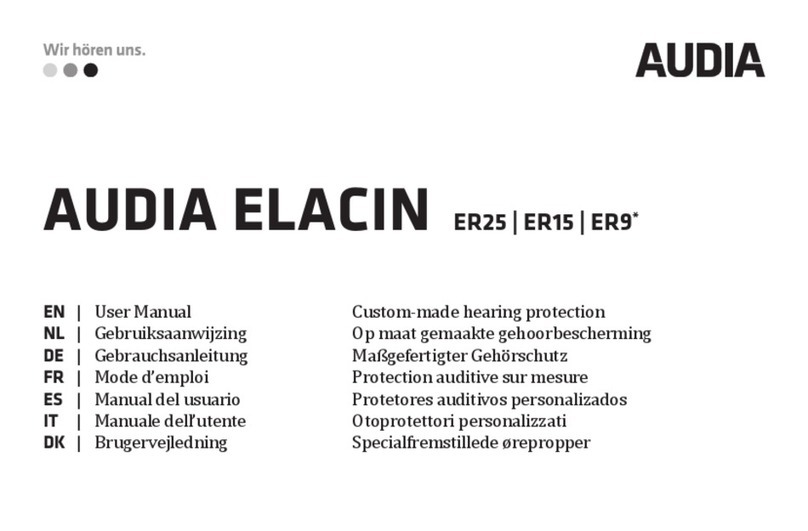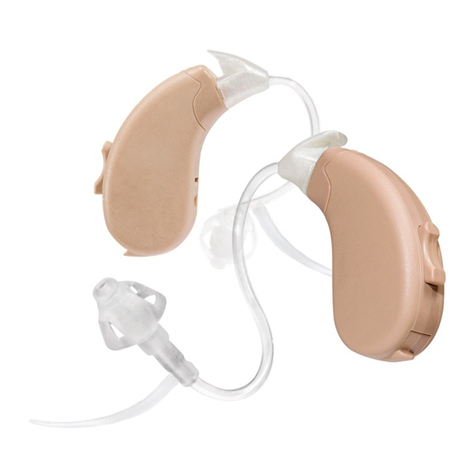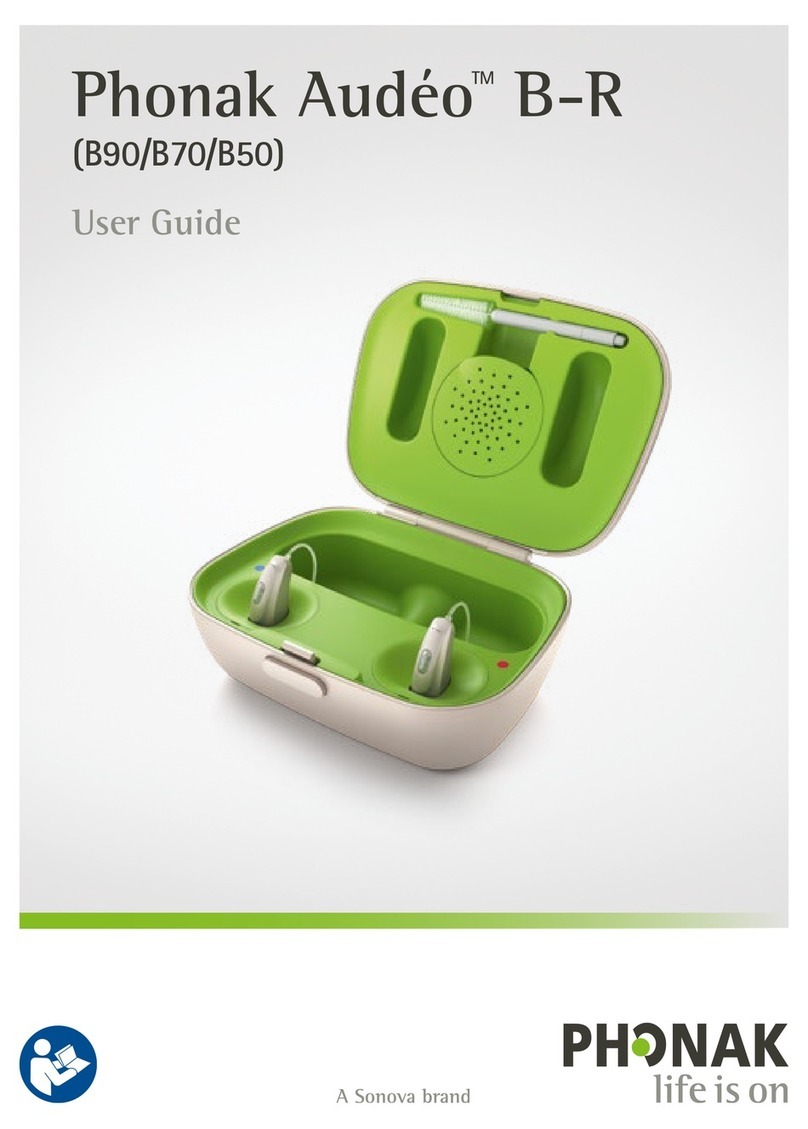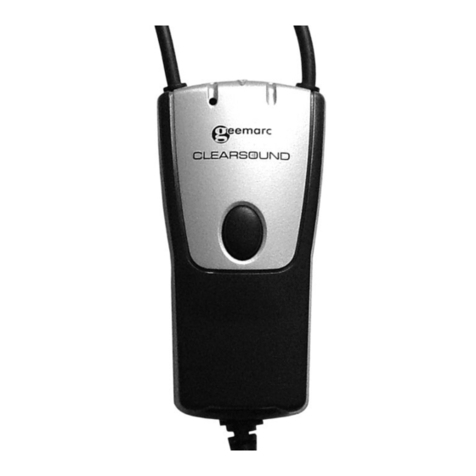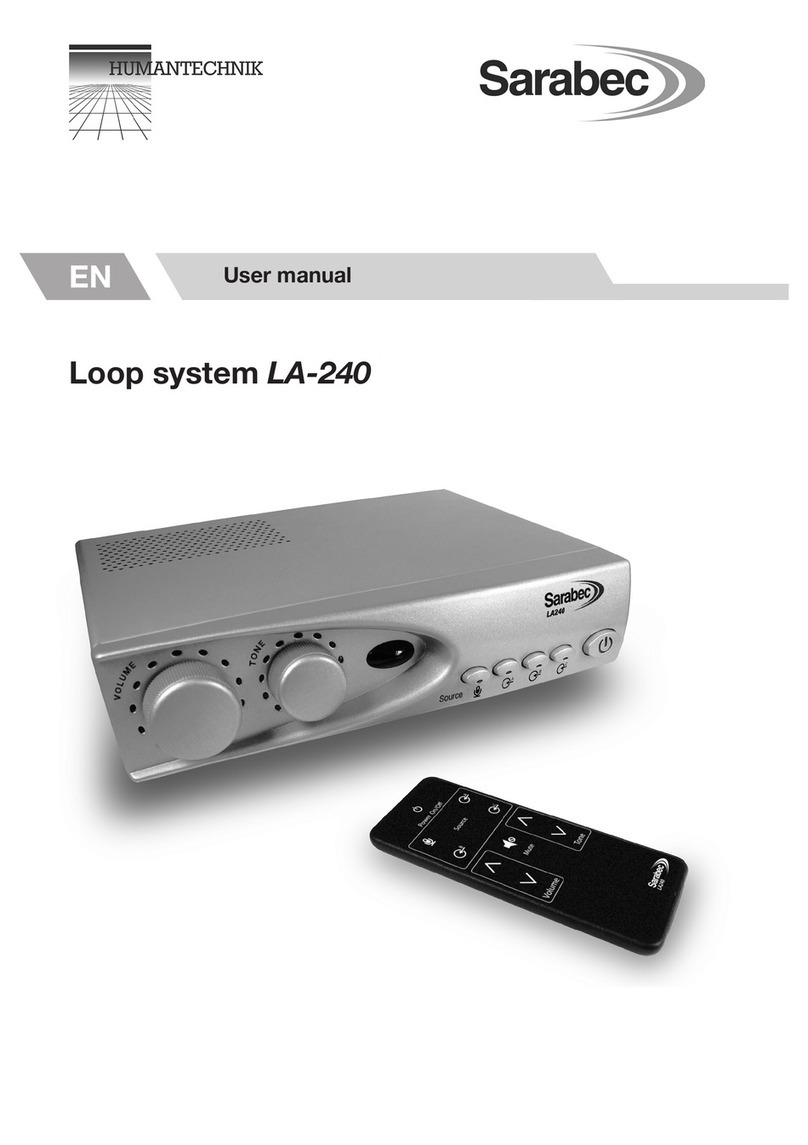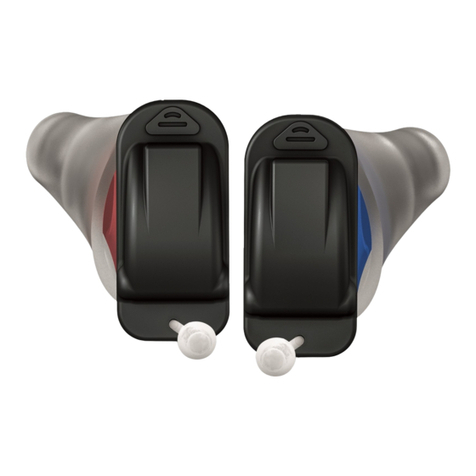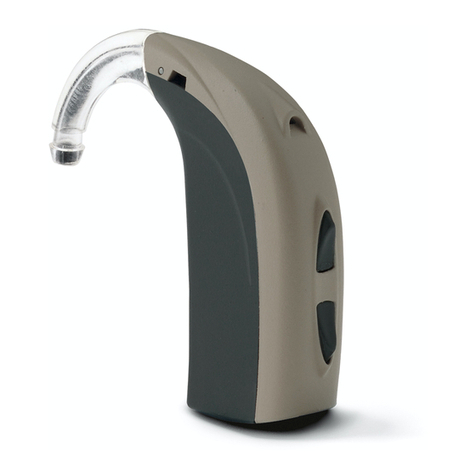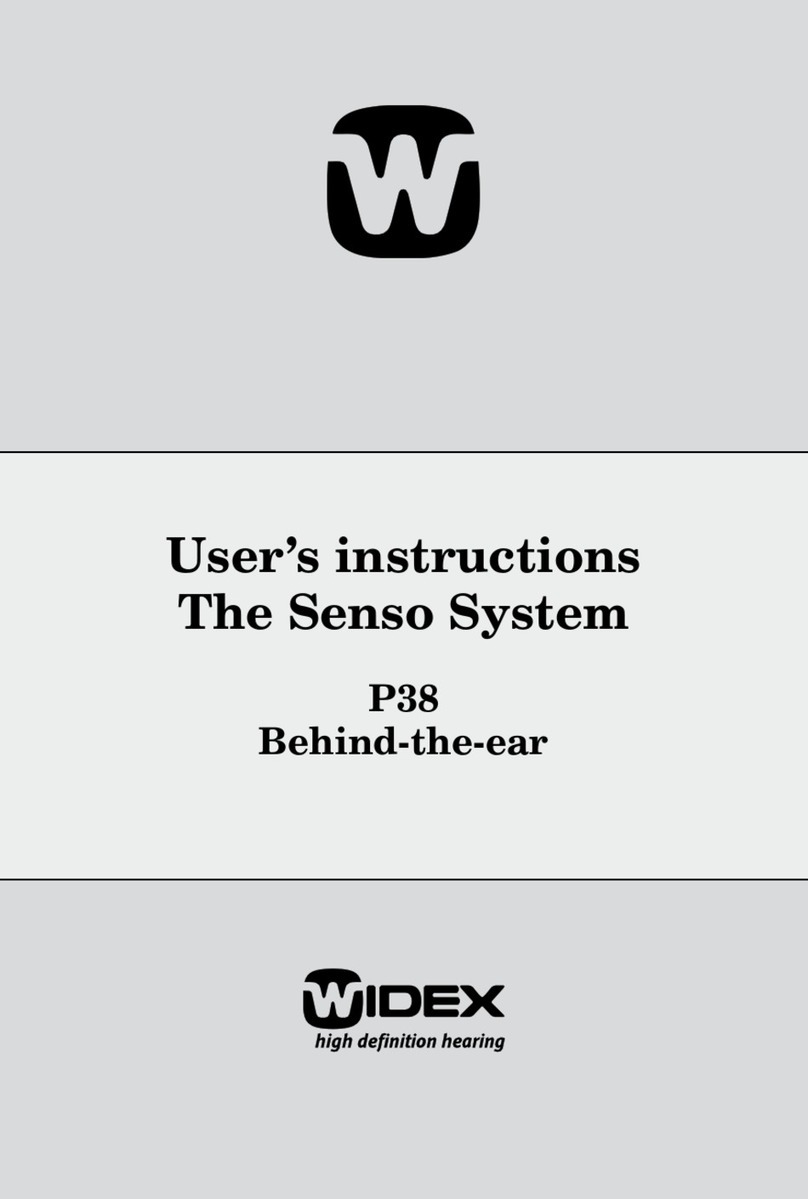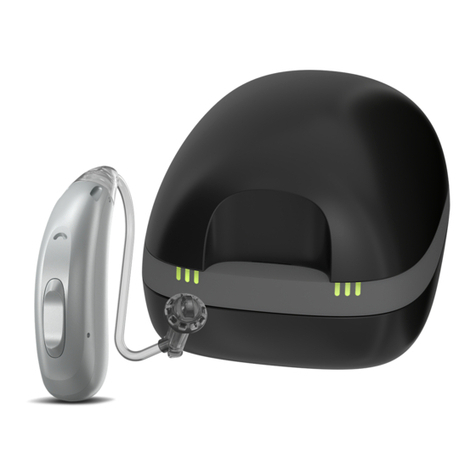Elacin Audia ER9 User manual

EN | User Manual Custom-made hearing protection
NL | Gebruiksaanwijzing Op maat gemaakte gehoorbescherming
DE | Gebrauchsanleitung Maßgefertigter Gehörschutz
FR | Mode d’emploi Protection auditive sur mesure
ES | Manual del usuario Protetores auditivos personalizados
IT | Manuale dell’utente Otoprotettori personalizzati
DK | Brugervejledning Specialfremstillede ørepropper
FI | Käyttöohje Räätälöidyt kuulosuojaimet
SE | Bruksanvisning Skräddarsydda hörselskydd
NO | Brukerveiledning Skreddersydd hørselsvern
ER9
RC13
Elacin

1. EN | User Manual
2. NL | Gebruiksaanwijzing
3. DE | Gebrauchsanleitung
4. FR | Mode d’emploi
5. ES | Manual del usuario
6. IT | Manuale dell’utente
7. DK | Brugervejledning
8. FI | Käyttöohje
9. SE | Bruksanvisning
10. NO |Brukerveiledning

Elacin RC13
1 2 3 4
Elacin RC13 minigrip
1 2 3 4
Elacin ER9
1 2 3 4

Elacin RC13 no grip
1 2 3 4
Attenuation characteristics
NL | Dempingskarakteristiek - DE | Dämpfungscharakteristik - FR | Caractéristique d’amortissement
ES | Características de atenuación - IT | Caratteristica di smorzamento - DK | Dæmpningsegenskaber
FI | Vaimennusominaisuudet - SE | Dämpningsegenskaper - NO | Dempingsegenskaper
Filter f in Hz 125 250 500 1000 2000 4000 8000 H M L SNR
Elacin ER9
APVf
in dB
10.4 9.4 5.8 6.8 10.3 9.2 15.5 10 8 8 10
Elacin RC13 4.1 6.7 10.8 12.8 18.1 19.3 12.8 17 13 9 15
Filter f in Hz 125 250 500 1000 2000 4000 8000
Elacin ER9
Mf
in dB
14.3 12.2 10.8 10.3 13.5 12.6 19.2
Elacin RC13 7.3 9.5 13.8 16.0 22.2 22.9 17.1
Filter f in Hz 125 250 500 1000 2000 4000 8000
Elacin ER9
Sf
in dB
3.9 2.8 5.0 3.5 3.2 3.4 3.7
Elacin RC13 3.2 2.8 2.9 3.1 4.0 3.5 4.3

f in Hz
H in dB
M in dB
L in dB
SNR in dB
Mf in dB
Sf in dB
APVf in dB
Frequency in Hertz.
Attenuation value in predominantly high-frequency noise spectrum (f > 2000 Hz).
Attenuation value in predominantly medium-frequency noise spectrum (f > 500 and f < 2000 Hz).
Attenuation value in predominantly low-frequency noise spectrum (f < 500 Hz).
Single Number Rating, to be deducted from C-weighted noise level.
Average attenuation value at given frequency f in decibel.
Standard deviation at given frequency f in decibel.
Assumed Protection Value (Mf - 1x Sf ), at given frequency f in decibel.
EN
f en Hz
H en dB
M en dB
L en dB
SNR en dB
Mf en dB
Sf en dB
APVf en dB
Fréquence en Hertz.
Indice d’affaiblissement partiel dans les hautes fréquences (f > 2000 Hz).
Indice d’affaiblissement partiel dans les fréquences moyennes (f > 500 and f < 2000 Hz).
Indice d’affaiblissement partiel dans les basses fréquences (f < 500 Hz).
Indice de qualité de transmission, à déduire du niveau de bruit pondéré en fonction du facteur C.
Affaiblissement moyen (en décibel).
Ecart type (en décibel).
Valeur de protection présumé (en décibel) (Assumed Protection Value).
FR
f in Hz
H in dB
M in dB
L in dB
SNR in dB
Mf in dB
Sf in dB
APVf in dB
Frequentie in Hertz.
Gemiddelde dempingswaarde in overwegend hoogfrequent geluidsspectrum (f > 2000 Hz).
Gemiddelde dempingswaarde in overwegend middenfrequent geluidsspectrum (f > 500 en f < 2000 Hz).
Gemiddelde dempingswaarde in overwegend laagfrequent geluidsspectrum (f < 500 Hz).
Dempingswaarde, af te trekken van C-gewogen geluidsniveau.
Gemiddelde dempingswaarde bij gegeven frequentie f in decibel.
Standaarddeviatie bij gegeven frequentie f in decibel.
Gemiddelde dempingswaarde per frequentie f (Mf - 1x Sf ) in decibel (Assumed Protection Value).
NL
f in Hz
H in dB
M in dB
L in dB
SNR in dB
Mf in dB
Sf in dB
APVf in dB
Frequenz in Hertz.
Dämmungswert in einem überwiegend hochfrequenten Lärmspektrum (f > 2000 Hz).
Dämmungswert in einem überwiegend mittelfrequenten Lärmspektrum (f > 500 und f < 2000 Hz).
Dämmungswert in einem überwiegend niedrigfrequenten Lärmspektrum (f < 500 Hz).
Dämmungswert, abzuziehen vom C-bewerteten Lärmpegel.
Durchschnittlichter Dämmungswert bei der genannten Frequenz f in Dezibel.
Standardabweichung bei der genannten Frequenz f in Dezibel.
Durchschnittlichter Dämmungswert (Mf - 1x Sf ) bei der genannten Frequenz f in Dezibel.
DE

f en Hz
H en dB
M en dB
L en dB
SNR en dB
Mf en dB
Sf en dB
APVf en dB
Frecuencia en hercios
Valor de atenuación medio en espectro de ruido predominantemente de alta frecuencia (f > 2000 Hz).
Valor de atenuación medio en espectro de ruido predominantemente de frecuencia media (f > 500 y f < 2000 Hz).
Valor de atenuación medio en espectro de ruido predominantemente de frecuencia baja (f < 500 Hz).
Nivel global de atenuación, deducido del nivel de presión sonora ponderado C.
Características de atenuación media según la frecuencia f dada.
Desviación estándar según la frecuencia f dada.
Valor de protección asumida (Mf - 1x Sf ) en dB, según la frecuencia f dada.
ES
f i Hz
H i dB
M i dB
L i dB
SNR i dB
Mf i dB
Sf i dB
APVf i dB
Frekvens i Hertz.
Gennemsnitlig dæmpningsværdi i overvejende højfrekvent lydspektrum (f > 2.000 Hz).
Gennemsnitlig dæmpningsværdi i overvejende mellemfrekvent lydspektrum (f > 500 og f <2.000 Hz).
Gennemsnitlig dæmpningsværdi i overvejende lavfrekvent lydspektrum (f < 500 Hz).
SNR-værdi (Single Number Rating), skal trækkes fra C-vægtet støjniveau.
Gennemsnitlig dæmpningsværdi ved en givet frekvens f i decibel .
Standardafvigelse ved en givet frekvens f i decibel
Gennemsnitlig dæmpningsværdi pr. frekvens f (Mf - 1x Sf) i decibel (Assumed Protection Value).
DK
f in Hz
H in dB
M in dB
L in dB
SNR in dB
Mf in dB
Sf in dB
APVf in dB
Frequenza in Hertz.
Valore medio di smorzamento in uno spettro prevalentemente ad alte frequenze ( f > 2000 Hz).
Valore medio di smorzamento in uno spettro prevalentemente a medie frequenze (f > 500 e f < 2000 Hz).
Valore medio di smorzamento in uno spettro prevalentemente a basse frequenze (f < 500 Hz).
Riduzione semplificata del livello di rumore, valore da sottrarre al livello sonoro ponderato C.
Valore medio di smorzamento alla frequenza f indicata in decibel.
Deviazione standard alla frequenza f indicata in decibel.
Valore medio di smorzamento per frequenza f (Mf - 1x Sf) in decibel (Assumed Protection Value).
IT
Taajuus (Hz)
H-vaimennusarvo (dB)
M-vaimennusarvo (dB)
L-vaimennusarvo (dB)
SNR (dB)
Mf – vaimennuksen ka. (dB)
Sf – peruspoikkeama (dB)
APVf – oletettu suojaus (dB)
Taajuus hertseinä.
Vaimennusarvo enimmäkseen korkeataajuisen melun alueella (f > 2000 Hz).
Vaimennusarvo enimmäkseen keskitaajuisen melun alueella (f > 500 ja f < 2000 Hz).
Vaimennusarvo enimmäkseen matalataajuisen melun alueella (f < 500 Hz).
Single Number Rating -arvo, vähennetään C-painotetusta melutasosta.
Keskimääräinen vaimennus annetulla taajuudella (f) desibeleinä.
Peruspoikkeama annetulla taajuudella (f) desibeleinä.
Oletettu suojausarvo (Mf - 1x Sf) annetulla taajuudella (f) desibeleinä.
FI

f i Hz
H i dB
M i dB
L i dB
SNR i dB
Mf i dB
Sf i dB
APVf i dB
Frekvens i Hertz.
Dämpningsvärde i övervägande högfrekvensljudspektrum (f >2 000 Hz).
Dämpningsvärde i övervägande lågfrekvensljudspektrum (f >500 och f <2 000 Hz).
Dämpningsvärde i övervägande lågfrekvensljudspektrum (f <500 Hz).
Enkelnummergradering, Single Number Rating, som dras av från C-viktad ljudnivå.
Medeldämpningsvärde vid viss frekvens f i decibel.
Standardavvikelse vid viss frekvens f i decibel.
Förmodat skyddsvärde, Assumed Protection Value (Mf – 1× Sf), vid viss frekvens f i decibel.
SE
f i Hz
H i dB
M i dB
L i dB
SNR i dB
Mf i dB
Sf i dB
APVf i dB
Frekvens i Hertz.
Dempingsverdi i hovedsakelig høyfrekvente støyspektre (f > 2000 Hz).
Dempingsverdi i hovedsakelig middelsfrekvente støyspektre (f > 500 og f < 2000 Hz).
Dempingsverdi i hovedsakelig lavfrekvente støyspektre (f < 500 Hz).
Enkel nummerklassifisering skal trekkes fra C-vektet støynivå.
Gjennomsnittlige dempingsverdier ved en gitt frekvens f i desibel.
Standard avvik ved en gitt frekvens f i desibel.
Forventet beskyttelsesverdi (Mf – 1 x Sf) ved en gitt frekvens f i desibel.
NO

The ER9 and RC13 filters do not fulfil the minimum attenuation requirements according to
the EN 352-2. For daily noise exposure levels L
ex
,8
hof 87 dB(A) (for the ER 9) and 88 dB(A)
(for the RC13), a residual sound level at the ear of L
ex
,8
h= 79 dB(A) is reached. If the exposure time
is halved to 4 h, a level at the ear of L
ex
,8
h= 79 dB(A) is also reached for a noise exposure level
of LAeq = 90 dB(A).
The hearing protectors are suitable for 8 h use per day in following areas:
The typical noise situations in these areas, the daily noise exposure level at the ear L
ex
,8
hdoes
not exceed the value of 85 dB(A). Thus a secure protection is generally assured by ER 9 and
be suitable.
or further information.
EN

De ER9- en RC13-filters voldoen niet aan de minimale vereisten voor demping volgens norm
EN 352-2. Voor de dagdosis geluid L
ex
,8
hvan 87 dB(A) (voor ER9) en 88 dB(A) (voor RC13) wordt
een ruisniveau van L
ex
,8
h= 79 dB(A) bij het oor bereikt. Wanneer de tijd van blootstelling wordt
gehalveerd naar 4 uur wordt ook een niveau van L
ex
,8
h= 79 dB(A) bij het oor bereikt bij
een geluidexpositieniveau van LAeq = 90 dB(A).
zangers en percussie,
In deze omstandigheden is de dagdosis geluid bij het oor L
ex
,8
hniet hoger dan 85 dB(A).
Doorgaans volstaat een bescherming met ER9 en RC13. In gevallen met ongebruikelijk hoge
voor ondersteuning of meer informatie.
EN352-norm maar voldoet wel aan alle relevante
NL

Die Filter ER9 und RC13 erfüllen nicht die minimalen Dämpfungsanforderungen gemäß EN 352-2.
Für tägliche Lärmexpositionspegel L
ex
,8
hvon 87 dB(A) (für den ER9) und 88 dB(A) (für den RC13)
wird ein Restschalldruckpegel am Ohr von L
ex
,8
h= 79 dB(A) erreicht. Wenn die Expositionsdauer
auf 4 Std. halbiert wird, wird ein Pegel am Ohr von L
ex
,8
h= 79dB(A) ebenfalls für einen Lärmex-
positionspegel von L
A
eq
= 90dB(A) erreicht.
Der Gehörschutz ist für einen Einsatz von 8Std. täglich in den folgenden Bereichen geeignet:
In den typischen Lärmsituationen in diesen Bereichen überschreitet der tägliche Lärmexpositions-
pegel am Ohr L
ex
,8
hnicht den Wert von 85dB(A). Darum bieten ER9 und RC 3 im Allgemeinen
sicheren Schutz. In bestimmten Fällen mit ungewöhnlich lauten Situationen sind die Filter
um Unterstützung oder weitere Informationen zu erhalten.
EN352, erfüllt jedoch alle relevanten
DE

Les filtresER9 etRC13 ne sont pas conformes aux exigences d'atténuation définies par la norme
EN352-2. Pour des niveaux d'exposition sonore quotidiens L
ex,8
h
de 87dB(A) (pour le modèle ER9) et
de 88dB(A) (pour le modèle RC13), un niveau sonore résiduel à l'oreille de L
ex,8
h
= 79dB(A) est atteint.
Si le temps d'exposition est réduit à 4h, un niveau sonore à l'oreille de L
ex,8
h
= 79dB(A) est également
atteint pour un niveau d'exposition sonore de L
Aeq
= 90dB(A).
Ces protections auditives peuvent être utilisées quotidiennement pendant 8h dans les contextes suivants:
(sauf instruments à vent, cuivres, percussions et chanteurs)
Pour un environnement sonore typique dans ces différents contextes, le niveau quotidien d'exposition
sonore à l'oreille L
ex,8
h
ne dépasse pas 85dB(A). Les filtresER9 etRC13 assurent donc généralement
une bonne protection. Pour les cas particuliers dans des environnements particulièrement bruyants, les
FR

Los filtros ER9 y RC13 no cumplen con los requisitos mínimos de atenuación según el estándar EN 352-2.
En una exposición diaria a niveles de ruido L
ex,8
h
de 87 dB(A) (para el ER 9) y 88 dB(A) (para RC 13), se
alcanza un nivel residual de ruido en el oído de L
ex,8
h
= 79 dB(A). Si el tiempo de exposición se reduce a
4 h, se alcanza también un nivel en el oído de L
ex,8
h
= 79 dB(A) para un nivel de exposición de ruido
de L
Aeq
= 90 dB(A).
Los protectores auditivos pueden usarse durante 8 horas al día en los siguientes situaciones:
de viento y percusión
instrumentos de viento y percusión
En las situaciones típicas de ruido en estas áreas, el nivel de exposición acústica diaria L
ex,8
h
, no supera el
valor de 85 dB(A). Por ello, el ER 9 y el RC 13 garantizan por lo general una protección segura.
no sean adecuados. En caso de duda, póngase en contacto con su proveedor o escriba a [email protected]
para obtener asistencia o información adicional.
ES

I filtri ER9 e RC13 non rispettano i requisiti minimi di attenuazione del rumore previsti dallo standard
EN 352-2. Per i livelli di esposizione giornaliera al rumore L
ex
,8
hdi 87 dB(A) (per il filtro ER 9) e 88
dB(A) (per il filtro RC 13), si raggiunge un livello sonoro residuo all’orecchio pari a L
ex
,8
h= 79 dB(A).
Se il tempo di esposizione viene dimezzato a 4 ore, anche in questo caso si raggiunge un livello
all’orecchio di L
ex
,8
h= 79 dB(A) per un livello di esposizione al rumore pari a LAeq = 90 dB(A).Gli
otoprotettori possono essere utilizzati fino a 8 ore al giorno nelle seguenti aree di attività:
Nelle situazioni di rumore tipiche, caratteristiche di queste aree, il livello di esposizione giornaliera
al rumore di L
ex
,8
hall’orecchio non supera il valore di 85 dB(A). In genere, i filtri ER 9 e RC 13
garantiscono una protezione affidabile. In casi specifici, quando la rumorosità è particolarmente
assistenza o ulteriori informazioni.
EN352 ma soddisfa tutti i requisiti pertinenti
IT

EN352 men er i overensstemmelse med alle krav
ER9- og RC13-filtrene opfylder ikke minimumskravene til dæmpning iht. EN 352-2.
Ved daglige eksponeringsniveauer L
ex
,8
taf 87 dB(A) (for ER 9) og 88 dB(A) (for RC 13), opnås
der et restlydniveau ved øret på L
ex
,8
t= 79 dB(A). Hvis eksponeringstiden halveres til 4 timer, nås
niveauet ved øret for L
ex
,8
t= 79 dB(A) også ved et støjeksponeringsniveau på LAeq = 90 dB(A).
Ørepropperne er velegnede til brug i op til 8 timer dagligt i følgende områder:
De typiske støjsituationer i disse områder, det daglige støjeksponeringsniveau ved øret L
ex
,8
t,
overskrider ikke værdien 85 dB(A). Således opnås sikker beskyttelse normalt med ER 9 og
velegnede.
I tvivlstilfælde bedes du kontakte din leverandør eller [email protected] for at få yderligere hjælp
og information.
DK

ER9- ja RC13-kuulosuojaimet eivät täytä EN352-2 -standardin äänenvaimennuksen
vähimmäisvaatimuksia. ER9-mallissa saavutetaan 87dB(A):n päivittäinen melualtistustaso
L
ex
,8
hja RC13-mallissa 88dB(A):n jäännöskohinataso L
ex
,8
h
altistumisaika puolitetaan neljään tuntiin, korvan luona taso L
ex
,8
h= 79dB(A) saavutetaan myös
melualtistustasolla LAeq = 90 dB(A).
Kuulosuojaimia voidaan käyttää kahdeksan tuntia päivässä seuraavissa käyttökohteissa:
laulajia)
Edellä mainituilla käyttöalueilla päivittäinen melutaso korvan lähellä L
ex
,8
hei ylitä arvoa 85dB(A).
Näin ollen ER9 ja RC13 takaavat yleensä riittävän suojaustason. ER9- ja RC13-kuulosuojaimet
eivät ehkä sovellu tilanteisiin, joissa äänenvoimakkuus on tavallista kovempi. Mikä sinulla on
ER9- ja RC13-kuulosuojaimet eivät täytä EN352-vaatimuksia, mutta ovat kuitenkin henkilösuojaimia
ER9- ja RC13-kuulosuojaimet ovat IFA:n (rekisterinro 0121; 53757 Sankt Augustin, Saksa) sertifioimia.
FI

ER9- och RC13-filtren uppfyller inte minimikraven för dämpning enligt EN 352-2. För nivåer
för daglig bullerexponering L
ex
,8
hpå 87 dB(A) (för ER 9) och 88 dB(A) (för RC13) uppnås en
restljudnivå i örat på L
ex
,8
h= 79 dB(A). Om exponeringstiden halveras till 4 timmar nås även en nivå
på L
ex
,8
h= 79 dB(A) i örat för en bullerexponeringsnivå på LAeq = 90 dB(A).
Hörselskydden är lämpliga för 8 timmars användning per dag i följande områden:
Den typiska bullersituationen i de här områdena innebär att nivån för daglig bullerexponering i
örat L
ex
,8
hinte överstiger ett värde på 85dB(A). Det innebär att skydd i allmänhet kan garanteras
olämpliga. Om du är osäker kontaktar du leverantören eller går till [email protected] för att få hjälp
eller mer information.
SE

ER9- og RC13-filtrene oppfyller ikke minimumskravene til støydemping i henhold til EN 352-2. For
daglige støyeksponeringsnivåer L
ex
,8
hpå 87dB(A) (for ER9) og 88dB(A) (for RC13) når et lydnivå
på L
ex
,8
h= 79dB(A) inn i øret. Hvis eksponeringstiden halveres til fire timer, når et nivå på L
ex
,8
h=
79dB(A) også inn i øret, noe som gir et støyeksponeringsnivå på LAeq = 90dB(A).
sangere
Med den vanlige støyen på disse stedene vil ikke det daglige støyeksponeringsnivået for øret L
ex
,8
h
overstige verdien på 85dB(A). Dermed får du en sikker beskyttelse med ER9 og RC13. I spesielle
kan du kontakte leverandøren din eller sende en e-post til [email protected] for å få hjelp eller mer
informasjon.
NO

Elacin Custom-made hearing protection
IMPORTANT: Read this instruction carefully before use
and keep both the package and the user manual.
General
sounds. Each pair of hearing protectiors is issued with an identification number.
Use
Check that the hearing protectors are clean before you use them. If necessary use an ear wax remover(1
to clean ear wax out of the sound tube of the hearing protector.
The hearing protector with the letter ‘L’ is for the left ear. The hearing protector with the letter ‘R’ is
the hearing protectors.
(1 An ear wax remover is available separately. Ask your hearing specialist for more information.
Insertion
Insertion may be less smooth at first use. Application of included ear cream on the part of the hearing
protector that goes into the ear will improve ease of insertion (see illustration next page).
Removal
Remove the hearing protector using a rotary forward motion.
OR, alternatively, place your index finger against the lower part of your ear and press upwards a number
of times. The hearing protector is then slowly released from the ear. When it no longer seals you can safely
remove it.
Immediately after use, put the hearing protectors in the case supplied with them.
EN USER MANUAL | 1

Maintenance
Clean your Elacin hearing protections regularly with a damp cloth. For a regular and thorough cleaning of
your custom-made hearing protectors, we advise you to use the Elacin Hygiene and HygienePLUS kit.
These cleaning products help you to keep your hearing protectors in the best possible shape and prolong
the life-span. For more information ask your hearing specialist.
Warning
Use Elacin hearing protectors carefully in accordance with the instructions. If the instructions above
are not followed, the protection certainty of the hearing protectors cannot be guaranteed.
Use your Elacin hearing protectors always in noisy situations!
NOTE: the protection is reduced substantially even if you only remove them for a very short period.
This product may be adversively affected by certain chemical substances. Further information should be
sought from the manufacturer.
If applicable: These hearing protectors should not be used where there is a risk that the connecting cord
could be caught up during use, for example, by a machine.
Sudden or fast removal of the hearing protectors out of the ear canal may damage the ear drum.
Changes in body weight can affect the fit of a hearing protector to the extent that it will not fully close
off the hearing canal.
The hearing protectors are custom-made and are therefore not transferable.
The hearing protectors are designed to be inserted in the hearing canal only.
Replace your hearing protectors after four years.
The greatest possible care is taken in the manufacturing of your Elacin hearing protectors.
Immediately contact your supplier if you notice anything out of the ordinary.

Elacin ER9
1. Hold the hearing protector between your thumb and index finger, with your thumb resting on
the identification number.
2. Turn the hearing protector such that your thumb is on top and hold it by your ear.
3. Insert the hearing protector by rotating it backwards and, using gentle pressure, putting it into
4. Using gentle pressure from your index finger on the filter, move the hearing protector up and down
slightly until it seals comfortably.
Elacin RC13
1. Hold the hearing protector’s handle between your thumb and index finger, with your thumb
against the filter.
2. Turn the hearing protector such that your thumb is on top and hold it by your ear.
3. Insert the hearing protector by rotating it backwards and, using gentle pressure, putting it into
the ear canal. The handle is now at the top and horizontal, and your thumb is pointing downwards.
4. Using gentle pressure from your index finger on the handle, move the hearing protector up and
down slightly until it seals comfortably.
This manual suits for next models
1
Table of contents
Languages:
Other Elacin Hearing Aid manuals
Popular Hearing Aid manuals by other brands

hi Health Innavations
hi Health Innavations BTE Series ESSENTIALS GUIDE
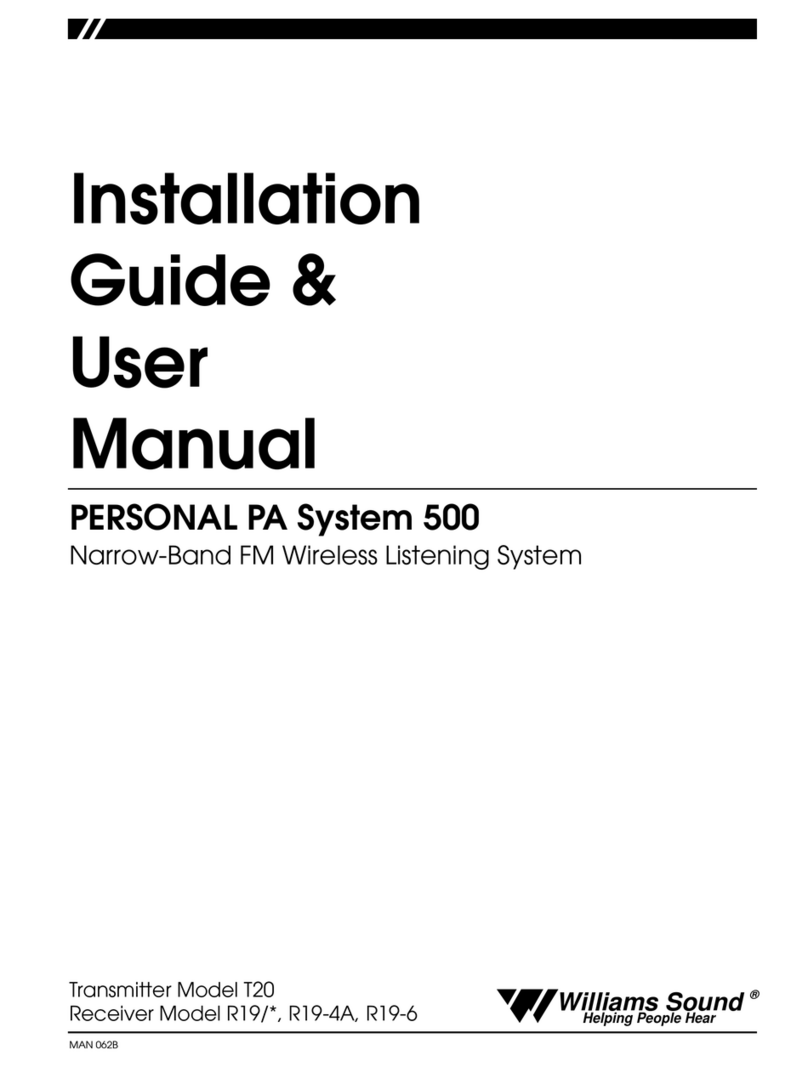
Williams Sound
Williams Sound PERSONAL PA System 500 Installation guide & user manual

Alango Technologies
Alango Technologies BeHear PROXY quick start guide
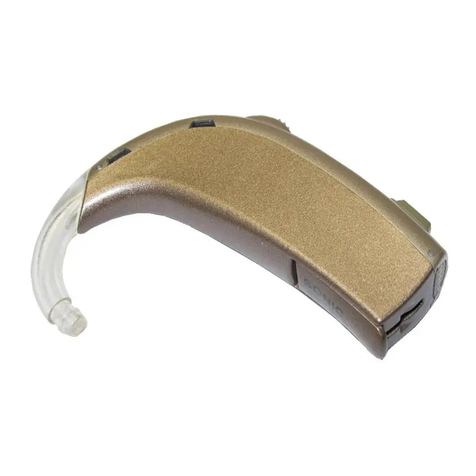
Sonic
Sonic Journey 80 Super Power user guide
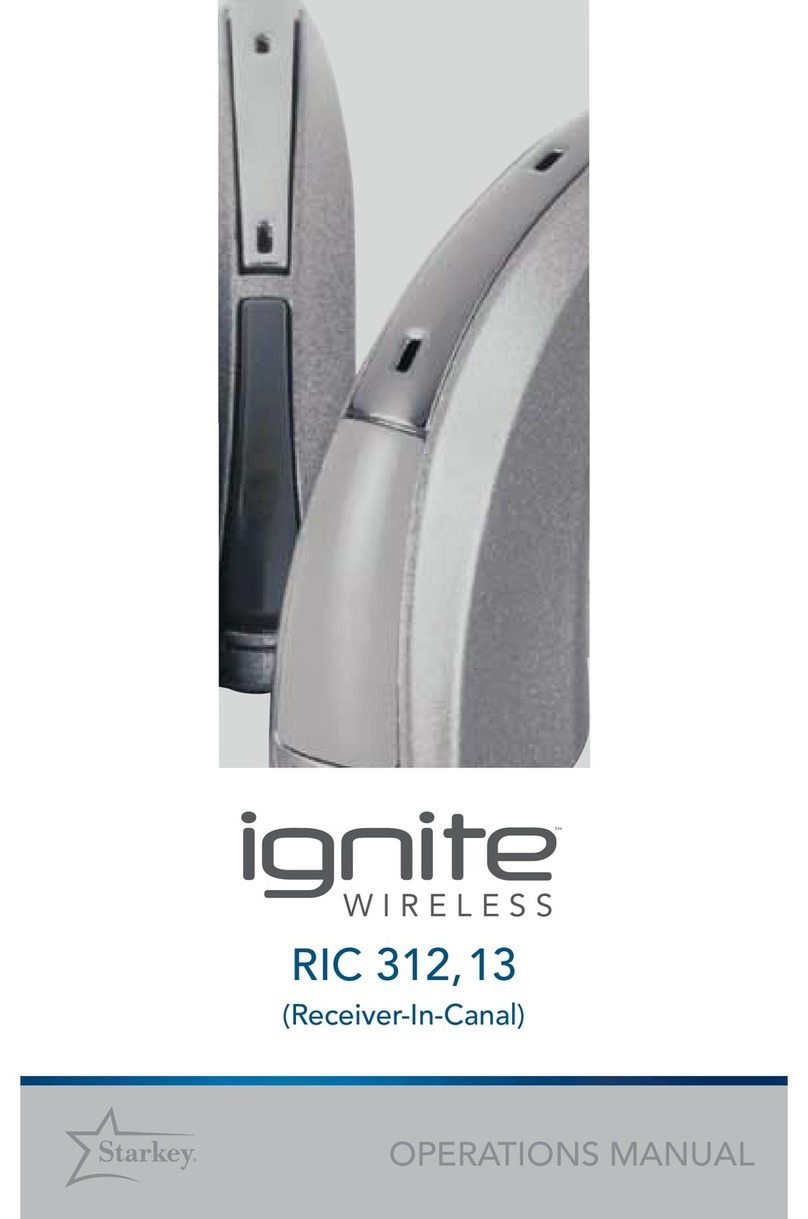
Ignite
Ignite RIC 312 Operation manual
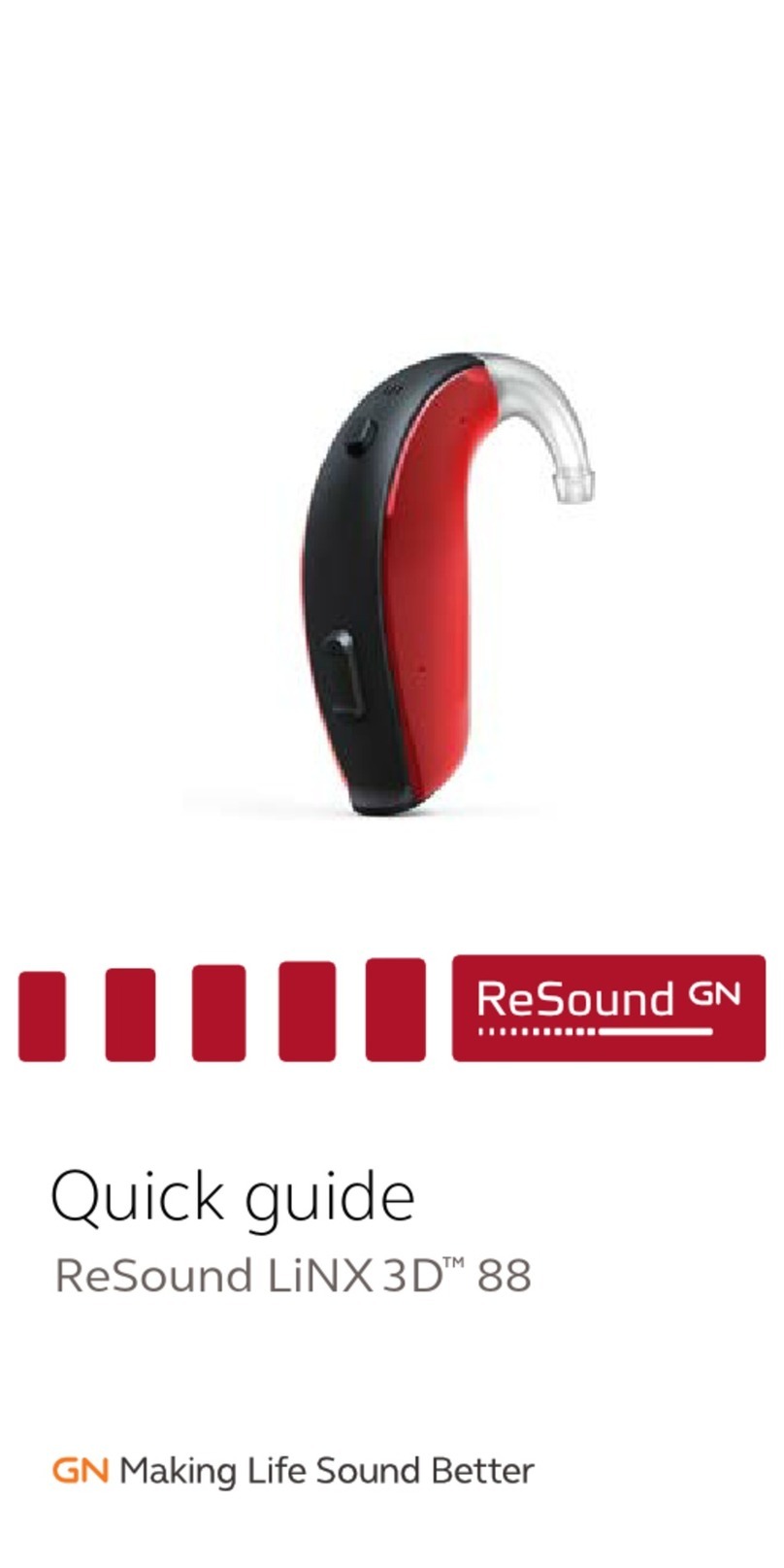
ReSound
ReSound LiNX 3D 88 quick guide
